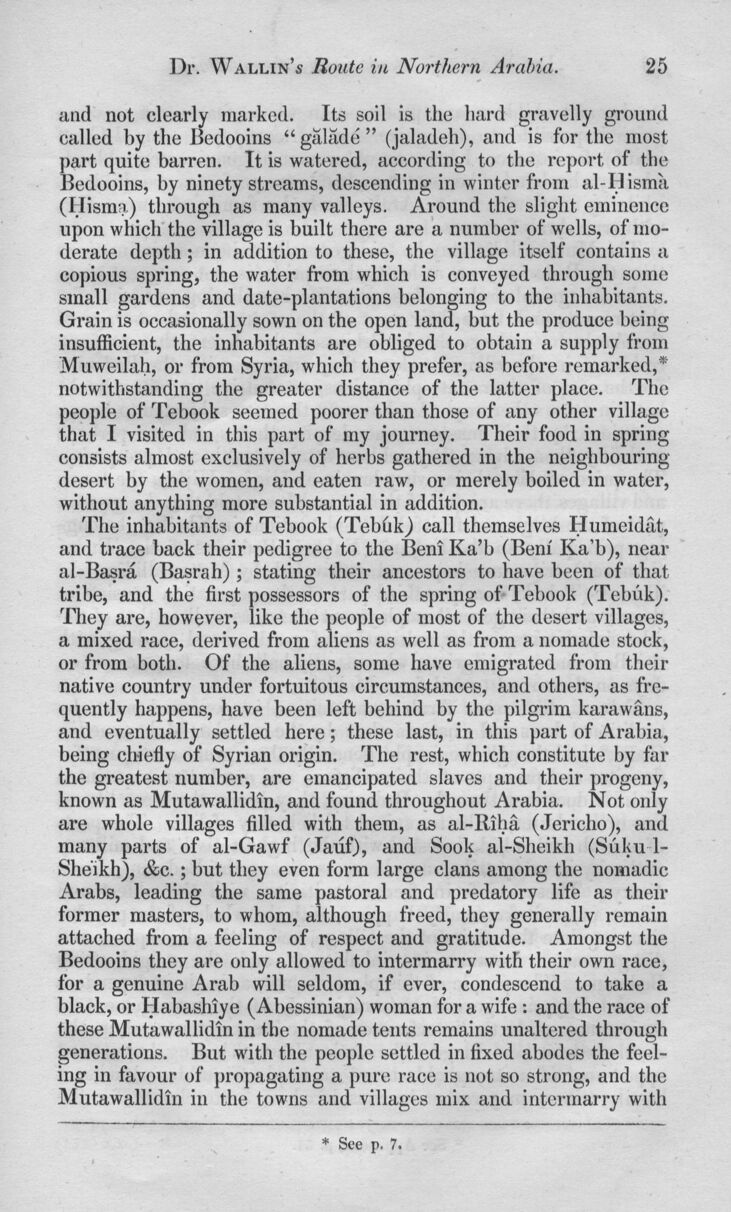
Full resolution (JPEG) - On this page / på denna sida - Route in Northern Arabia

<< prev. page << föreg. sida << >> nästa sida >> next page >>
Below is the raw OCR text
from the above scanned image.
Do you see an error? Proofread the page now!
Här nedan syns maskintolkade texten från faksimilbilden ovan.
Ser du något fel? Korrekturläs sidan nu!
This page has never been proofread. / Denna sida har aldrig korrekturlästs.
[-and-]{+Dr. Wallin’s Route in Northern Arabia.
25
and+} not clearly marked. Its soil is the hard gravelly ground
called by the Bedooins “galade ” (jaladeh), and is for the most
part quite barren. It is watered, according to the report of the
Bedooins, by ninety streams, descending in winter from al-Hisma
(Hisma) through as many valleys. Around the slight eminence
upon which the village is built there are a number of wells, of
moderate depth ; in addition to these, the village itself contains a
copious spring, the water from which is conveyed through some
small gardens and date-plantations belonging to the inhabitants.
Grain is occasionally sown on the open land, but the produce being
insufficient, the inhabitants are obliged to obtain a supply from
Muweilah, or from Syria, which they prefer, as before remarked,*
notwithstanding the greater distance of the latter place. The
people of Tcbook seemed poorer than those of any other village
that I visited in this part of my journey. Their food in spring
consists almost exclusively of herbs gathered in the neighbouring
desert by the women, and eaten raw, or merely boiled in water,
without anything more substantial in addition.
The inhabitants of Teboolc (Tebfik) call themselves Humeidat,
and trace back their pedigree to the Beni Ka’b (Beni Ka’b), near
al-Basra (Basrah); stating their ancestors to have been of that
tribe, and the first possessors of the spring of Tebook (Tebuk).
They are, however, like the people of most of the desert villages,
a mixed race, derived from aliens as well as from a nomade stock,
or from both. Of the aliens, some have emigrated from their
native country under fortuitous circumstances, and others, as
frequently happens, have been left behind by the pilgrim karawans,
and eventually settled here; these last, in this part of Arabia,
being chiefly of Syrian origin. The rest, which constitute by far
the greatest number, are emancipated slaves and their progeny,
known as Mutawallidin, and found throughout Arabia. Not only
are whole villages filled with them, as al-ltiha (Jericho), and
many parts of al-Gawf (Jaiif), and Sook al-Sheikh (Suku
1-She’ikh), &c.; but they even form large clans among the nomadic
Arabs, leading the same pastoral and predatory life as their
former masters, to whom, although freed, they generally remain
attached from a feeling of respect and gratitude. Amongst the
Bedooins they are ouly allowed to intermarry with their own race,
for a genuine Arab will seldom, if ever, condescend to take a
black, or Habashiye (Abessinian) woman for a wife: and the race of
these Mutawallidin in the nomade tents remains unaltered through
generations. But with the people settled in fixed abodes the
feeling in favour of propagating a pure race is not so strong, and the
Mutawallidin in the towns and villages mix and intermarry with
* See p. 7.
<< prev. page << föreg. sida << >> nästa sida >> next page >>